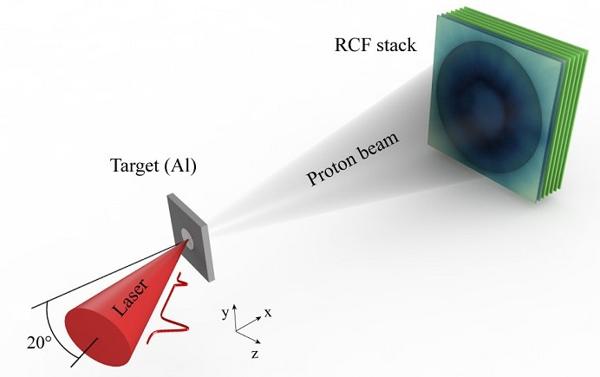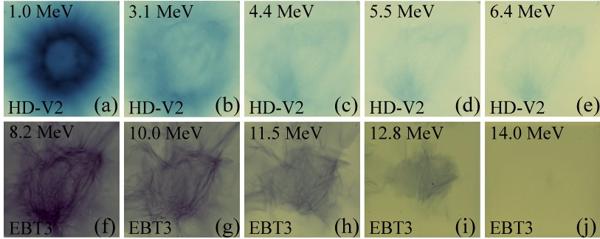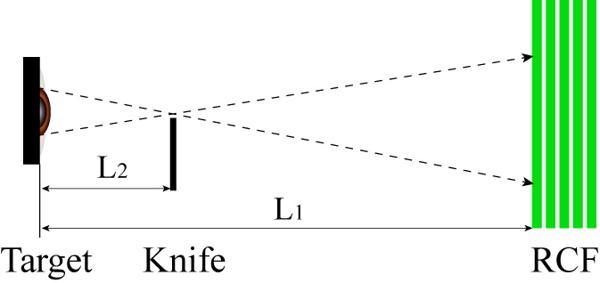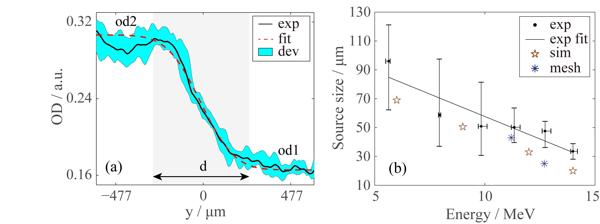Laser-driven proton source has important application prospects in the fields of tumor therapy, laser fusion and proton imaging. These applications put forward different requirements for the parameters of proton beam, such as energy, divergence angle, laminarity, source size and number, which need to be measured conveniently and accurately in the experiment.
In the work published on High Power Laser Science and Engineering, Vol. 10, Issue 1(C. Y. Qin, H. Zhang, S. Li, et al. Mapping non-laminar proton acceleration in laser-driven target normal sheath field[J]. High Power Laser Science and Engineering, 2022, 10(1): 010000e2), the authors have developed a single shot multi-dimensional characterization method for non-laminar proton beam, and realized the measurements of energy, divergence angle, source size and number of laser-driven non-laminar proton beam.

Figure 1 Experimental set-up
Firstly, the characteristics of non-laminar proton acceleration were characterized by RCF stacks (shown in Fig. 1). Using a low contrast, 7.2 J / 35 fs laser to irradiate a 10-micron-thick planar aluminum target, the cut-off energy of the proton obtained is 13 MeV and the divergence angle is 24°. The proton beam presents ring-like distribution at the low energy and filamentation distribution at the high energy (seen in Fig. 2). Particle-In-Cell (PIC) simulations show that the laser pre-pulse will bring a large scale of pre-plasma on the front and rear surfaces of the target. When the main pulse acts on the front surface of the target, a large electron current is generated. If this current intensity exceeds the Alfven current limit, the electron backflow behind the target will occur. This kind of oppositely moving electron beam will cause Weibel instability near the critical density surface in the pre-plasma behind the target, resulting in a periodic filamentous strong magnetic field with high intensity and short lifetime of only a few hundred femtoseconds. Then the forward electron current will bring a weak annular magnetic field with long lifetime of several picoseconds. Under the influence of early filamentous magnetic field, high-energy protons show filamentous distribution, while low-energy protons show annular distribution after long-time deflection of annular magnetic field. This kind of proton beam disturbed by strong magnetic field, which shows non laminarity, is different from the proton beam accelerated by the scheme of target normal sheath acceleration.

Figure 2 The beam profiles of protons with different proton energy detected by RCF stacks.
Further, the size of non-laminar proton source was measured by knife edge technique (shown in Fig. 3). A 200-micron-thick metal blade was placed at L2 = 12 mm behind the target, and the RCF stack was located at L1 = 94 mm behind the target. The measured results are shown in Fig. 4. There is an obvious penumbra region in the proton distribution. According to the size of penumbra region, the size of proton source can be deduced. For proton energy > 5 MeV, the size of proton source is in the range of 30-110 μm. At the same time, it can be seen that the size of proton source decreases linearly with the increase of proton energy. The experimental results are consistent with the PIC simulated results, and are verified by grid imaging method in experiment.

Figure 3 Schematic diagram of measuring proton source size by knife edge technique.

Figure 4 The analysis of proton source size. (a) The optical density distribution in the proton penumbra area. (b) Proton source size as a function of different proton energy.
In recent years, with the completion or approval of projects for 10 PW or even 100 PW laser devices, the field of laser driven proton acceleration is expected to achieve rapid development. The characterization method combined with knife edge technique and RCF imaging technique can be applied to the study of laser driven non-laminar proton acceleration, and realize the single shot multi-dimensional measurement of proton beam parameters.


